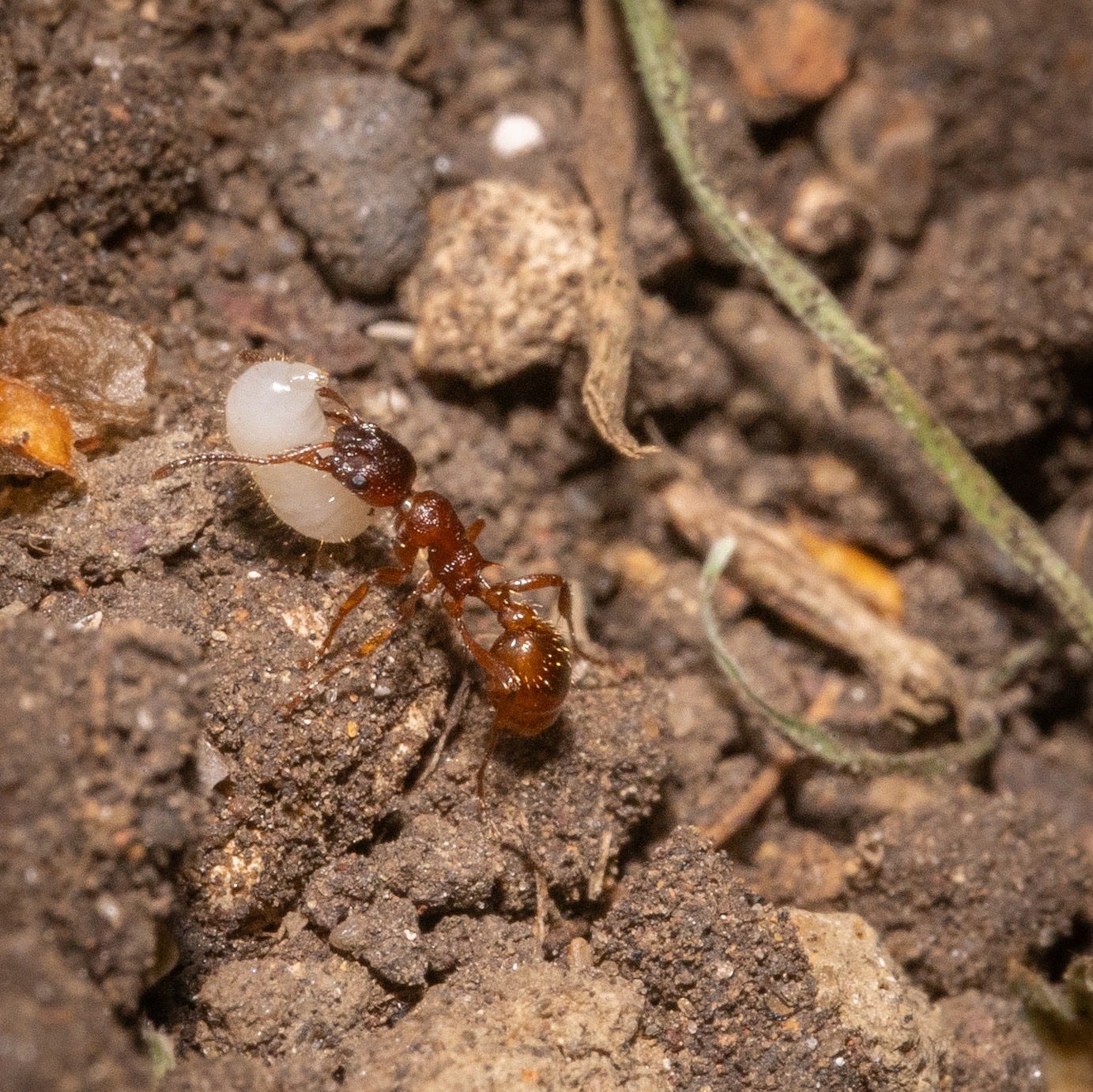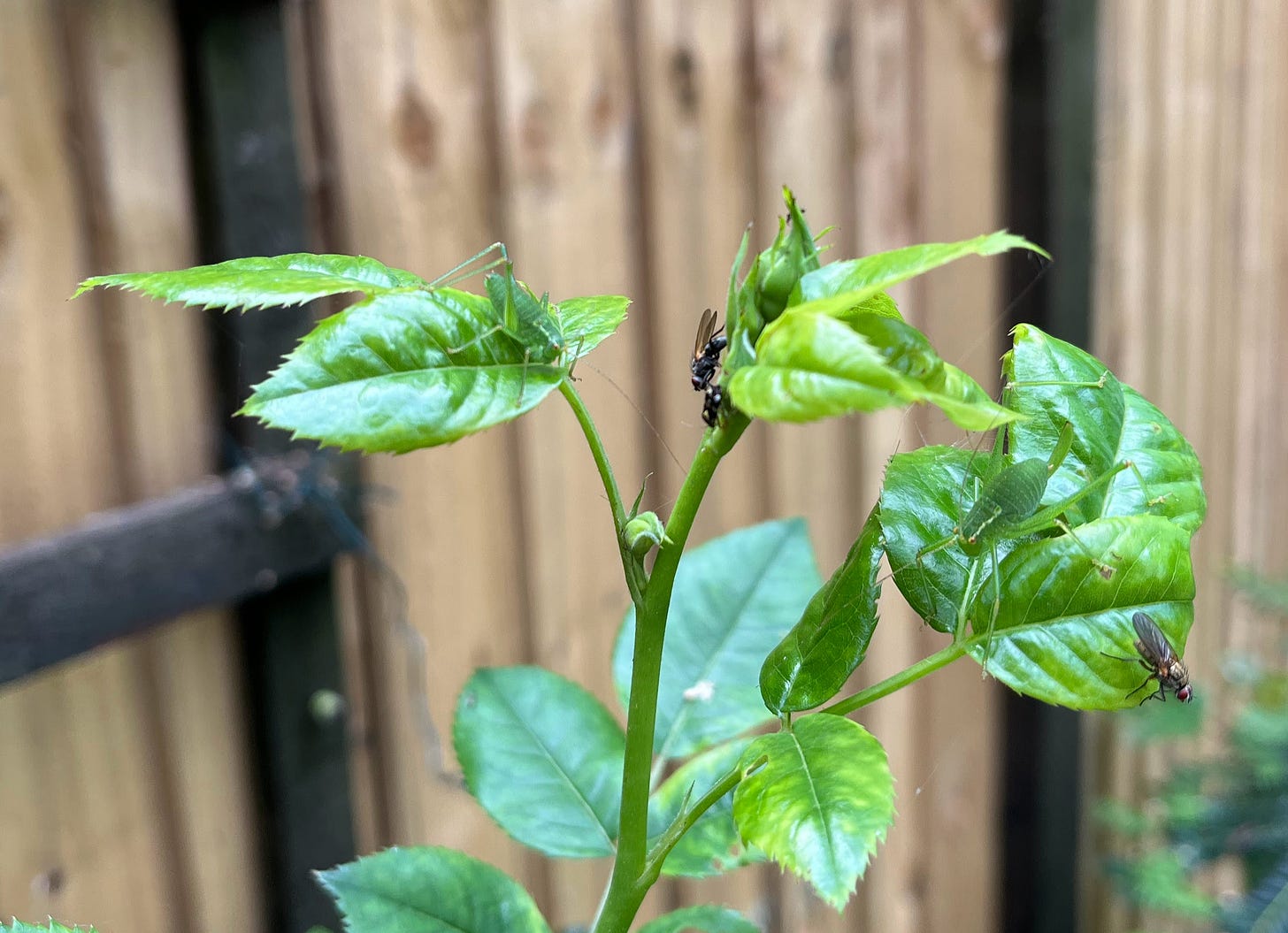One effect of my ongoing lack of employment is an over-exaggerated appreciation for the wildlife in my garden. Wildlife I have been worrying I’ll have to leave behind for months now.
I already loved most of it. Now, everything – even the Fire Ants – are my ‘little friends’. But these big, red ants are feisty!
They adore nesting in my potted plants, and their eggs are the same size as the adult black ants I knew and loved as a kid. No one ever warned me about the effect of using a magnifying glass on a sunny day to inspect their activities, but fortunately I was so surprised by the wisps of smoke rising from the ground that I stopped and ran away before I did any real harm.
Anyway, why ‘fire’ ants? Well this species is part of the family ‘Formicidae’, which you may be forgiven for thinking is so named because they produce formic acid. But in fact, the acid is named after the critter – formīca is Latin for ant.
It hardly matters which was named first when one of these red beasties has its jaws clamped firmly on your neck while it contorts its body so that it can sting you with acid. Fire indeed.
The huge jaws are surprisingly powerful, making it very difficult to ‘gently’ flick the ant away without harming it. (Happily, the painful sting makes it very difficult to care about the ant in that moment.)
They are not in the (similarly named) Formica family; a small mercy, as those ants can spray a jet of acid out of their rear ends! They also farm Aphids, and I have quite enough of those without any additional support.
The queen Fire Ants, of which there may be more than 100 in a single colony, can live for up to 15 years. While I do find ants fascinating, they pose a slight problem for me. All my garden plants are in pots, and if I have to move back to my parents’ house I am not sure they will welcome those containers of fire ants into their garden. I’m not wild about transporting them there in my car, either…
Bugging out
Another intriguing little creature I have in huge numbers is the Birch Catkin Bug. They are what’s known as ‘true bugs’. The notion of a ‘true’ bug really tickles me.
Unfortunately, so do these things every time they awaken from their winter slumber. Which, fine - I don’t mind finding a little bug on me and helping it back into the garden. But this species creates a strong smell when disturbed. They show up in such huge numbers that you can barely move without disturbing them, so my senses are assaulted by their dry, musky stank several times a day.
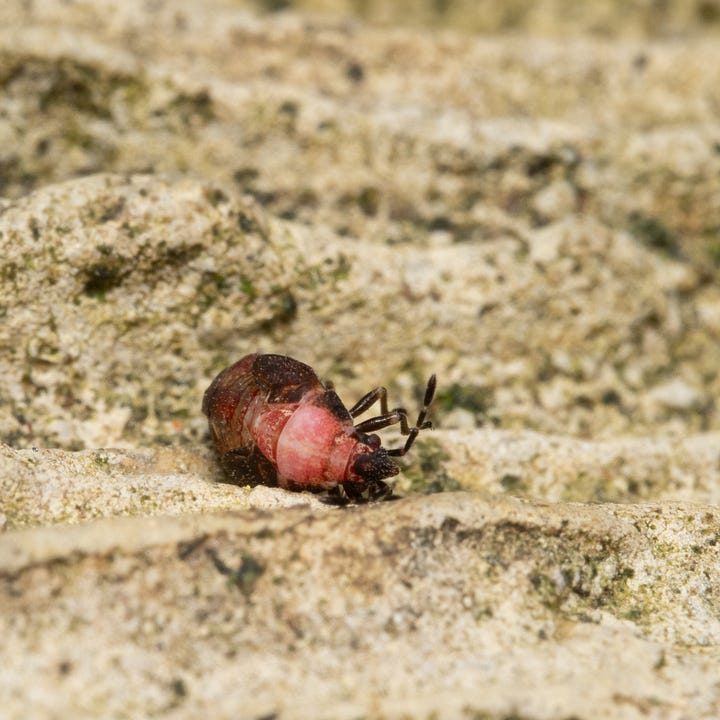
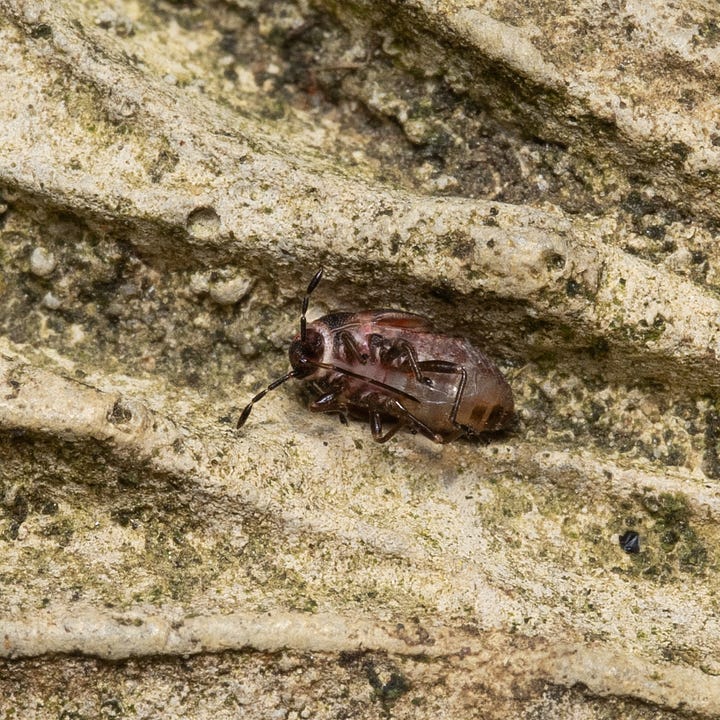
There are more than 80,000 (!) true bug species in the world, including cicadas, bedbugs and waterbugs. They are different to other types of insect in that they have a ‘piercing’ proboscis, used to stab and then suck up their meals, which range from sap to blood.
Much less dainty than, for example, Butterflies, which delicately unroll their proboscis and use it to sup on nectar.
And then we have the Parent Bugs. I don’t believe these ones smell. They’re lovely, big bugs that tend to their offspring well, hence the name. As a result, in most years they are plentiful visitors (although my very-enthusiastic winter pruning of the roses means I’ve not seen any this year).
Pond life
My pond is presenting me with another challenge. If I do have to move house, I think it’ll come with me. I’m rather attached to the large population of Water Hoglouses (hog lice?) that bumble around on the Hornwort.
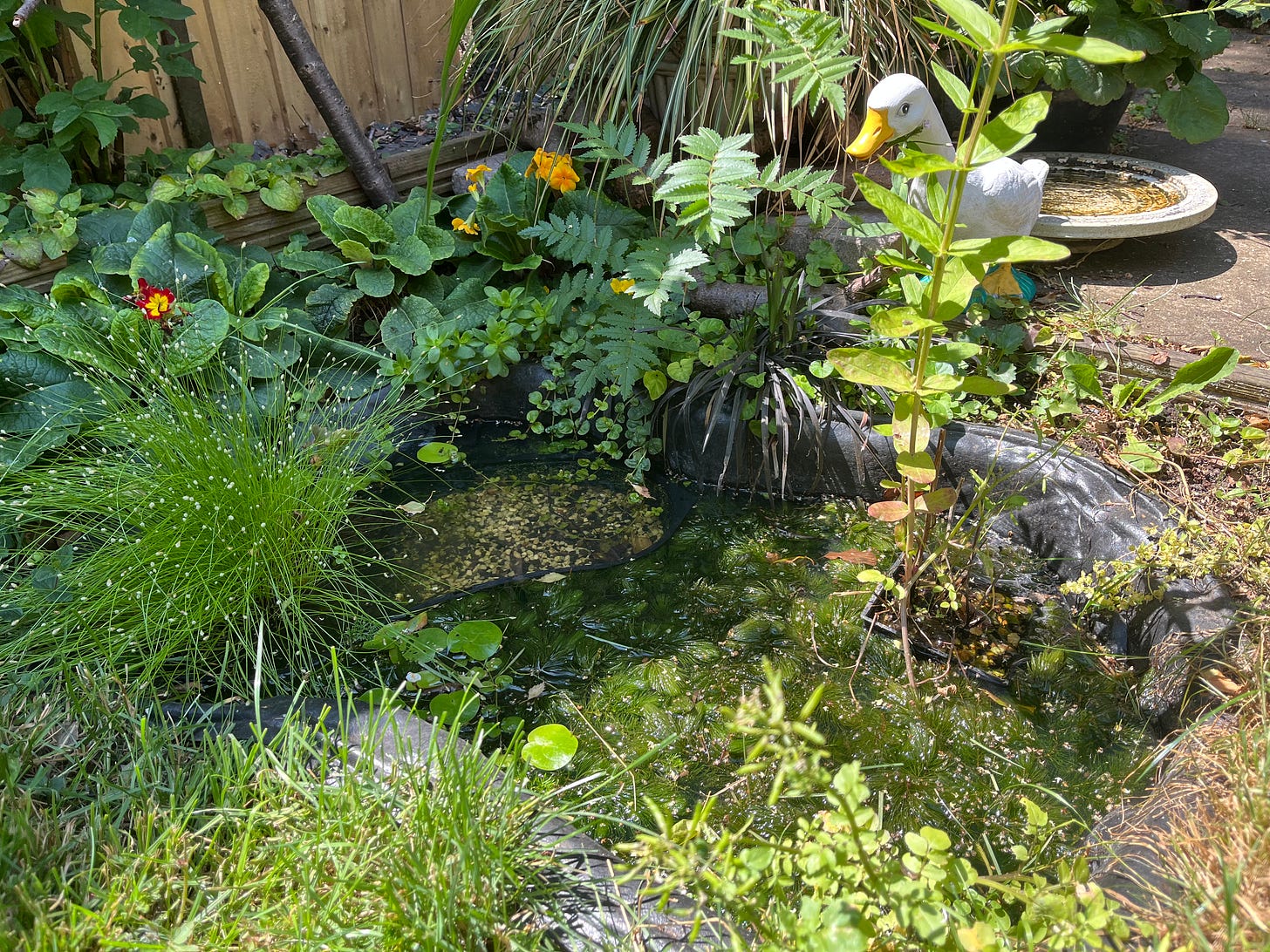
The hog lice are like your standard Woodlouse/slater, with extended legs and an aquatic lifestyle. They spend their days hoovering up dead plant matter and becoming food for even more interesting residents like water beetles and dragonfly larva.
In the video below, you can see the contents of a ‘pond dip’ in my pond. The large creature is the Hoglouse, the tiny ones are Water Fleas. The medium-sized critters are both fly larvae – the one with three hairs sticking out of its rear is an Upwing (which includes Mayflies) and the tumbling one is some sort of Mosquito.
Bloomin’ wildflowers
They wildflower area I replaced the original plastic grass with has attracted lots of butterflies and moths. They are also visited by my first grasshoppers and damselflies. Wildflowers in bloom at the moment include small white clouds of yarrow flowers, the last of the red poppies and a sprinkling of yellow buttercups and white daisies.
My roses may not have any Parent Bugs today, but there are two Speckled Wood Crickets in attendance.
Non-natives include the purple plumes of a salvia plant, the fading peachy dahlia and the Asiatic Lillies, that fortunately were spared by the lily beetles this year. I don’t mind the beetles, they’re beautiful red jewels. But their grubs are bulbous, wrinkled creatures that eat ravenously and produce a huge volume of ‘frass’ (poop) that often coats their bodies and the leaves below them. Like something from a horror movie.

One, two, tree
I am something of an accidental tree collector. You see, once a seed has sprouted, I can’t bring myself to pull it out like a weed. It’s a tree! Decades of potential life – it’s simply not appropriate fare for the garden waste bin.
So, of course, I have two Yews, a Rowan, two (six foot) ornamental Cherries and a Sycamore. The only ‘intentional’ trees are the Eucalyptus and an Acer.
The neighbours’ Rowan that towered over my garden and donated a seed was sadly chopped down last week. At this time of year, the berries are appearing – greenish yellow, unripe but full of potential. In winter, the thrushes in particular love to gorge themselves.
If it was still standing, it would be heaving with fledged birds today, hiding among its branches between trips to the feeders. Blue Tits, Great Tits, Dunnocks, Blackbirds and Robins, especially. But also a Wren who used it as a high perch from which to project its beautiful voice. And, recently, a male Blackcap too. The feeders are suspiciously quiet, though I’m blaming the heatwave for now.
The gubbins
That’s it for this week. I stayed very close to home on account of the heatwave – it’s been 32°C (90°F) and I’m simply not cut out for it! But there’s so much more I could have mentioned – spiders, harvestmen, bees, wasps and hoverflies. More wildflowers popping up between my paving stones. The squirrels, rats and mice that visit.
If you enjoyed this, please tap that little heart symbol, or the buttons below. It means the world to me!
I’ll be back next week! My Dad is finally getting himself a mirrorless camera, so I expect we’ll have wandered further afield than my humble garden on the hunt for slightly more exotic species. I can’t wait to share them with you.
Let me know what you’ve spotted in the meantime.


